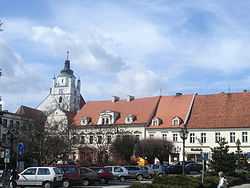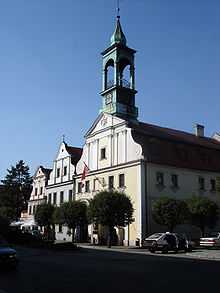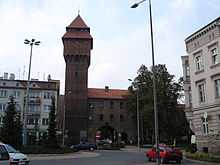Kluczbork
| Kluczbork | ||
|---|---|---|
 | ||
| ||
 Kluczbork | ||
| Coordinates: 50°59′N 18°13′E / 50.983°N 18.217°E | ||
| Country |
| |
| Voivodeship | Opole | |
| County | Kluczbork County | |
| Gmina | Gmina Kluczbork | |
| Established | 13th century | |
| Town rights | 1252 | |
| Government | ||
| • Mayor | Jarosław Kielar | |
| Area | ||
| • Total | 12.35 km2 (4.77 sq mi) | |
| Elevation | 190 m (620 ft) | |
| Population (2006) | ||
| • Total | 25,910 | |
| • Density | 2,100/km2 (5,400/sq mi) | |
| Time zone | CET (UTC+1) | |
| • Summer (DST) | CEST (UTC+2) | |
| Postal code | 46-200, 46-203 | |
| Area code(s) | +48 77 | |
| Car plates | OKL | |
| Website | http://www.kluczbork.pl | |
Kluczbork [ˈklud͡ʐbɔrk] (German: Kreuzburg O.S.) is a town in southwestern Poland with 26,670 inhabitants (2003), situated in the Opole Voivodeship. It is the capital of Kluczbork County and an important railroad junction. In Kluczbork the major rail line from Katowice splits into two directions - westwards to Wrocław and northwards to Poznań. It is also connected with Fosowskie.
History
Archaeologists have determined that settlement existed at the location of present-day Kluczbork by 1000-800 BC. The Scirii and Bastarnae settled in the vicinity and were followed ca. 100 BC by Celts and Vandals. The latter left Silesia ca. 400 AD, allowing West Slavs to settle the region.

In the 13th century the Knights of the Cross with the Red Star acquired the Kreuzburger Land and territory near Breslau (Wrocław), including the villages Ullrichsdorf (Młodoszów), Kuhnau (Kuniów), and Kotschanowitz (Chocianowice). The Knights began the settlement of Cruzeburg (Kreuzburg) on November 2, 1252. It received Magdeburg rights on February 26, 1253, the official date of foundation for the town. The Knights adjudicated in the town until 1274, when it was administered by a vogt of local Silesian dukes and juries were introduced. Dukes holding sway over Kreuzburg included Henryk IV Probus (until 1290), Henry III of Glogau (Głogów) (until 1309), and Konrad I of Oels (Oleśnica).
With the Congress of Visegrád (1335), King Casimir III of Poland renounced his rights to Silesia and Kreuzburg passed to King John I of Bohemia. The town was repeatedly pawned during this time period and received the privileges of a salt market in 1426. From 1480 the town was inhabited by a predominantly Polish-speaking populace. After the death of King Louis II of Hungary and Bohemia at the Battle of Mohács in 1526, Silesia was inherited by the Habsburg Monarchy of Austria.
On January 25, 1588, the day after the Battle of Byczyna, Polish troops under Jan Zamoyski plundered Kreuzburg. The townspeople accepted the Protestant Reformation in 1656 and converted the local Roman Catholic Church into a Lutheran one. The town passed to the direct control of the Catholic Habsburgs the following year. Kreuzburg had a population of approximately one thousand inhabitants in 1681.
Citing an obscure inheritance treaty, King Frederick II of Prussia invaded Silesia in 1740 and began the Silesian Wars. Kreuzburg was annexed by the Kingdom of Prussia in 1741 and became part of the Province of Silesia. The town became part of the German Empire upon the unification of Germany in 1871. It had a predominantly German-speaking population of 5,238 in 1875. The population grew to 8,750 by 1895 and 10,236 by 1900.
Following the Treaty of Versailles after World War I, Kreuzburg was involved in the Upper Silesian referendum in 1921. 95.6% (37,957 votes out of 39,703 participants) voted to remain within Weimar Germany instead of joining the Second Polish Republic. It became part of the Province of Upper Silesia; to differentiate between other places named Kreuzburg, it was known as Kreuzburg O.S. (referring to Oberschlesien, or Upper Silesia). By 1939 the town was the seat of Landkreis Kreuzburg O.S. and had 11,693 inhabitants.

Kreuzburg was occupied by the Soviet Union's Red Army in January 1945 during World War II. Following the war in 1945, the town was placed under Polish administration and given the Polish name Kluczbork. The Germans remaining in the town were largely expelled and replaced with Poles.
Over the centuries the town suffered repeatedly from conflagration. The textile industry began to grow in importance in 1553, but suffered a fire in 1569. Another great fire destroyed many houses on December 8, 1562. Another fire on April 23, 1737 almost completely destroyed the town, leaving only a few houses and the castle unscathed. Several years of rebuilding passed before it reached its previous size. Yet another fire occurred in 1819, in which burned down an almshouse built by Carl Gotthard Langhans in 1778. Eight of the Twelve Apostles, a complex of Baroque buildings in the town center, burned down in 1925.
Notable residents
- Adam Gdacjusz (1615–1688), parish priest in this city
- Jan Dzierżon (1811–1906), apiarist
- Gustav Freytag (1816–1895), dramatist and novelist
- Moritz Cohn (1844, born here - ?), Jewish Austrian writer[1]
- Walther von Lüttwitz (1859, Bogacica, near this city - 1942)
- Kurt Daluege (1897–1946), SS leader
- Joanna Gleich (born 1959), painter
- Edyta Górniak (born 1972), singer
- Tomasz Garbowski (born 1979), politician
- Romuald Jasinski b.1963, operasinger * Joachim Mencel (born 1966), jazzpianoplayer
- Henry III, Duke of Silesia-Glogau ()
- Henry V, Duke of Legnica ()
- Bolesław III the Generous ()
- Ludwik I the Fair ()
- Henryk IX of Lubin ()
- Ludwik II of Brzeg ()
- Fryderyk I of Legnica ()
- George II the Pious ()
- John Christian of Brieg ()
- George Rudolf of Legnica ()
- Barbara of Brandenburg, Duchess of Brieg ()
- Henry IV the Faithful ()
- Konrad I of Oleśnica ()
- Opole Main Station ()
- Bolko II of Opole ()
- Bernard of Niemodlin ()
- Bolko V the Hussite ()
- Nicholas I of Opole ()
International relations
Twin towns — Sister cities
Kluczbork is twinned with:
References
- This article incorporates information from the revision as of February 20, 2007 of the equivalent article on the German Wikipedia.
External links
| Wikimedia Commons has media related to Kluczbork. |
- Official website
- History of Kluczbork
- Jewish Community in Kluczbork on Virtual Shtetl
Coordinates: 50°59′N 18°13′E / 50.983°N 18.217°E
| ||||||||||||||
| ||||||||||

